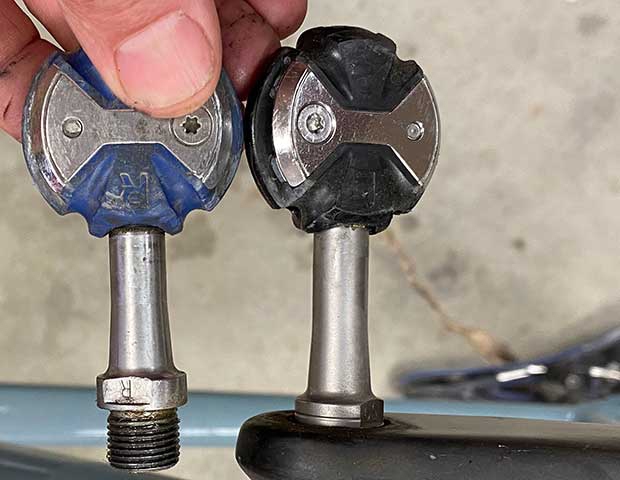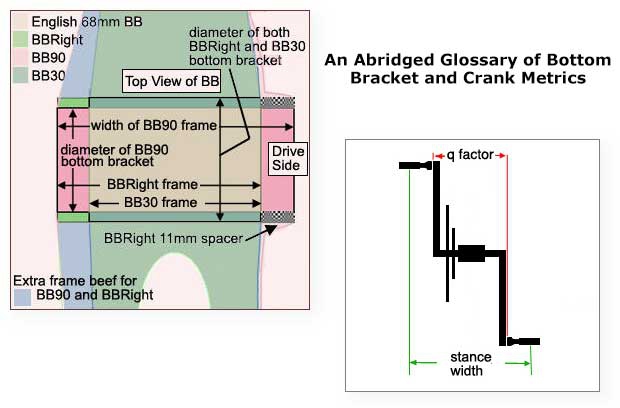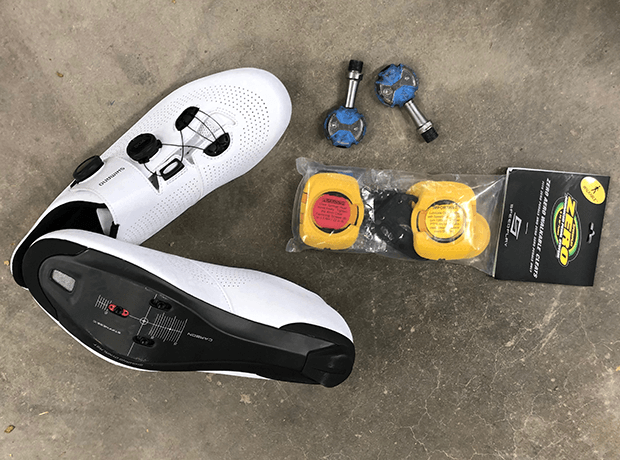Why We Like Longer Pedal Spindles
You might have noticed the relaunch of Speedplay, under the ownership of Wahoo Fitness. Of course, the additional big news will be the POWRLINK Zero, the power meter built into this pedal, targeted for sometime this summer.
But you know how we feel about power meter pedals: It’s a pedal before it’s a power meter, and all pedals must perform the function of pedals before they start getting big for their britches and decide to become electronic devices.
For me, one of those functions is the easy adjustment of the precise limits of pedal engagement (the limits of float during inward and outward heel rotation). This may not be an important feature to you and, if not, I don’t think it necessarily needs to be. It’s just important to me.

For some of us, longer spindles are also a valued Speedplay feature. Above is a pic of the older – pre-launch – Speedplay Zero pedals, and I use these rather than the new Wahoo Speedplays because I don’t have these new Zeros in a longer spindle yet to show you. You can see that the standard 53mm spindle, which I’m holding, next to the 59mm spindle in the pedal on the bike.
If you’re a bike fitter, spindle lengths are considered a solution for knees that don’t track vertically during the pedal cycle. This is perhaps the most-acknowledged use of the longer spindle. There’s another, less well-acknowledged reason, which I’ll get to.

This distance the cranks, or the pedals, sit apart from each other is either Q factor, or stance width, depending on what we’re referencing. As the image above illustrates, stance width is the distance from the center of the pedal platform across to the center of the opposite pedal’s platform (if you could imagine your crankarms both pointing up or down, instead of one pointing up and one pointing down). Q factor is the distance from the pedal shoulder – where the pedal faces up against the crankarm – to the opposing crankarm’s pedal shoulder. The image above also shows some bottom bracket standards, which I’ll talk about below. Just, as you can see, one could change the stance without changing the Q factor, simply by putting a pedal on the bike that has a longer spindle. My instinct tells me the often-unacknowledged reason for a longer spindle – my reason – is actually the reason most people have for needing that longer spindle, and I reference the bottom bracket standards above because this may help explain how we got to where we are today.
For many decades the bottom bracket width was fixed at 68mm, and the bearings sat inside of the bottom bracket shell. The Q factor for road bikes has been between 145mm and 150mm, depending on the component maker and groupset model, and it remains this distance (with an exception, explained further below). It should be noted that stance width for MTB is much wider (about 25mm wider) than it is for road bikes. But that's a separate issue and not germane to what I'm riding today.
Shimano chose to make a change in the bottom bracket width and for engineering reasons that made perfect engineering sense, but at a biomechanical cost (for some of us). Shimano chose to use a larger hollow bottom bracket (BB for short) spindle when it introduced Octalink decades ago. But that larger spindle really stressed the BB's bearings, so it placed those bearings just outside the BB shell with the introduction of its Hollowtech II system (also decades ago). The system is stronger, and you can make BB spindles hollow; you can make the crankarms lighter (and hollow), and everything is light and strong.
When Shimano chose to place the bearings outboard of the 68mm shell, those bearings added 11mm to each side of the bottom bracket. That meant that the entire BB shell was as wide as 90mm. By 2012 – when I made that graphic above showing the BB standards – you had a whole spitload of BB standards, including BBright, BB90, BB386 and so on, and which standard you wanted to use were really frame maker decisions. Do we sit the bearings out there, in the open air, on either side of our 68mm BB shell? Or do we make this elegant by widening the whole frame to 90mm at the BB, and suck up those bearings inside the frame?

Above is my gravel bike, and OPEN WI.DE, and the BB shell (the part of the frame the BB sits inside of) is pretty wide as you see. This bike uses the BB386 standard. The bearings are inside the frame’s BB shell. Below is a pic of Cervelo’s standard, which it calls BBright, and in this case one bearing is outboard the BB shell, and one bearing sits inside the BB shell.

These BB standards above are a riff off of two ideas and I need to roll the clock back a little to explain this. Realize that cranksets now sat 22mm farther apart from each other, at the point of the BB spindle, with Shimano’s new BB standard. Cannondale rejected this idea and many other companies followed suit. Cannondale championed a new, rebellious standard that called BB30, and the thinking was this: Fine, let’s beef up the BB area, but instead of placing the bearings further apart, let’s make the BB spindle larger in diameter, increasing the bearing sizes as well. BB30 means the spindle is 30mm in diameter, as opposed to the 24mm Shimano spindles. But let's do this without widening the bottom bracket.
There has been all sorts of admixtures of all of this, and in the two BB shells in the images above, they use both a 30mm spindle (or thereabouts), and the wider 90mm shell (or thereabouts). Well, BBright uses a 79mm shell, because it takes the old 68mm-wide shell and adds 11m to the non-drive side of the bike, but it assumes you'll place a bearing outside the shell on the drive side. The point being, companies using these standards capitulate to the idea that cranks now attach to the BB spindle 22mm further apart than they used to.
The T47 standard takes some of these new larger diameters, accepts the utility of them, but prefers the old threaded style BBs in place of pressfit. Fine. Whatever.
Native 68
What I call Native 68 (a term I came up with to explain what I’m writing here) refers to a crank and BB system that “honors” the 68mm-wide BB shell presented by the frame maker to the user. Cannondale’s cranks have in the past (and I assume still do, but I don’t know) honored this. You get that same flare out to the crankarm’s terminus that allow for splay-footers like me to ride how we want, with the heel clearance we need. This heel clearance is why I like longer pedal spindles.
Shimano does not make a native 68 system that I know of. Neither does SRAM. What SRAM offers is the same crank regardless of BB standard, with the same vertical aspect – the same clearance-limiting shape – and just a series of 11mm spacers that you put on one side or the other to space the BB out to 90mm, and then the cranks mount. I wish it were different, but it isn’t, and this is a problem for bike makers who want to make a native 68 bike, and for users who’d like to buy one. Below is a frameset I’m building up now (pardon our grease), and it’s made with a 68mm-wide BB shell (which makes sense, because this Quintana Roo SRsix is an aero road bike), but the SRAM cranks I’m putting on this bike are the same cranks that would go on a bike with a 90mm shell. In this case, the T47 DUB bottom bracket means there’s an (almost) 30mm-wide BB spindle with the bearings sitting outside the bike’s BB shell.

What this means is that the cranks will be more vertical in their aspect, and I have 11mm less heel clearance on each side. I can get that clearance back with a longer pedal spindle. This does not increase your bike’s Q factor, but it does increase your stance width. Does this make you less aero? I guess. By however much that is, by moving your pedal away from your bike 3mm, or 4mm, or 6mm. But you get to pedal the bike the way you want to.
Shimano and Speedplay are the 2 major brand options for longer spindles (and then there are smaller brands, like Keywin). The typical distance from pedal shoulder to pedal-center is 53mm. Almost all pedals are this, plus or minus a millimeter at most. Speedplay included. Shimano included. Shimano adds 4mm to its spindle length if you buy that road SPD pedal with the longer spindle. This works for me. Speedplay offers 56mm spindles, and 59mm (which I ride when I can get them), and 65mm.

Some other pedal makers offer pedals with just longer threads, that go all the way through the crankarm’s threaded hole and continue for a few millimeters on the other side of the crankarm. You can add a pedal washer or two, between the pedal shoulder and the pedal (put these spacers on before screwing the pedal into the crank) and you get the “longer” spindle that way.
In at least one case (on a fit bike) I kept hearing a repetitive thumping, and after about 30 minutes of searching everywhere on the bike, it was the longer threads on the pedal hitting the belt (this was a belt-drive bike). I could imagine, I guess, the pedal threads hitting the chain on a bike, but I don’t know that I’ve seen that happen.

I have shoes set up for standard spindles. They are positioned here at their limit of inward rotation. As you see, with the longer spindles I have additional clearance, and Speedplay’s cleats have limit screws – sort of like the top and bottom limit screws on a derailleur – that precisely dial in the pedal’s engagement limits. I can fine tune this shoe's engagement so that the heel just barely misses the crankarm as I pedal. I don't need the longer pedal spindle on a "Native 68" frame and crankset standard, but, that motif is almost extinct.
While I have 59mm spindles on my Speedplays, I can actually do fine with 56mm spindles. It’s the standard 53mm spindle that’s a little inconvenient. This means I can ride successfully with either Shimano or Speedplay. However, the point is, the reason I need those longer spindles is that today’s BB standards have forced the hand of crankset makers, and the lack of heel clearance on today’s cranks has taken away my ability to ride a 53mm spindle, because of my particular pedal stroke mechanics.
Finally, a little housekeeping. I indicated above that the two Q factors were about 150mm (road) and 175mm or thereabouts (MTB). While this is not entirely germane to the piece above, in order to be precise there is a third being developed. It’s 155mm, and it’s largely a gravel standard, but it’s used in both gravel and road. This is not a new BB standard; it's the way component makers are gaining a little clearance, by pushing their cranks a little further away from the frame. It’s used by Shimano (GRX) as well as by SRAM for certain of its drivetrains. It’s largely a response to either fatter tires, or to smaller chain ring sizes (like SRAM’s 43×30).







Start the discussion at forum.slowtwitch.com